SCIENCE 207 (exam)
The City College Of New York
All 18 results
Sort by

-
Nandani Hemnauth Bio 207 final intro
- Exam (elaborations) • 4 pages • 2022
-
- $9.49
- + learn more
Introduction Red blood cells (erythrocytes) are the most common type of blood cells and the vertebrate’s primary means of delivering oxygen to the cells of the body through the blood. The cells are composed of hemoglobin, a molecule that binds to oxygen and also carries some of the carbon dioxide produced in the tissue back to the lungs. The red color of erythrocytes is also the result of hemoglobin, which consists of iron and protein; increase or decrease in the concentration of hemoglo...
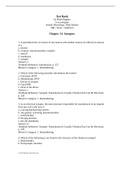
-
AnPhys3e Ch13 Test Bank y, Third Edition Hill • Wyse •|Anderson Chapter 13: Synapses
- Exam (elaborations) • 23 pages • 2022
-
- $9.49
- + learn more
1. A specialized site of contact of one neuron with another neuron (or effector) is known as a a. neuron. b. receptor–neurotransmitter complex. c. muscle. d. membrane. e. synapse. Answer: e Textbook Reference: Introduction, p. 327 Bloom’s Category: 1. Remembering 2. Which of the following transmits information the fastest? a. Ionotropic EPSP b. Metabotropic IPSP c. Electrical synapse d. Fast EPSP e. None of the above Answer: c Textbook Reference: Synaptic Transmission Is Usu...

-
Animal Physiology,Third EditionHill • Wyse • Anderson Chapter 8:,Chapter 27,Chapter 29, and Chapter 28 100% verified question and answers
- Package deal • 6 items • 2022
-
- $18.49
- + learn more
Chapter 8: Aerobic and Anaerobic Forms of Metabolism,Chapter 29: Kidneys and Excretion,Chapter 5: Transport of Solutes and Water,Chapter 5: Transport of Solutes and Water,Chapter 28: Water and Salt Physiology of Animals in Their Environments and Chapter 27: Water and Salt Physiology: Introduction and Mechanisms
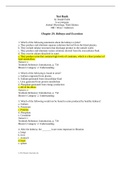
-
Animal Physiology, Third Edition Hill • Wyse • Anderson Chapter 29: Kidneys and Excretion
- Exam (elaborations) • 20 pages • 2022
- Available in package deal
-
- $10.49
- + learn more
1. Which of the following statements about the kidneys is false? a. They produce and eliminate aqueous solutions derived from the blood plasma. b. They include tubular structures that discharge product to the outside world. c. They produce and eliminate watery solutions derived from the extracellular fluid. d. They excrete solutes dissolved in water. e. They produce urine that contains high levels of creatinine, which is a direct product of lipid metabolism. Answer: e Textbook Reference:...
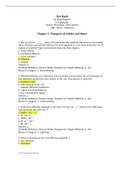
-
Animal Physiology, Third Edition Hill • Wyse • Anderson Chapter 5: Transport of Solutes and Water
- Exam (elaborations) • 29 pages • 2022
- Available in package deal
-
- $9.49
- + learn more
1. The process of _______ arises from the molecular agitation that exists in all systems above absolute zero and the tendency for such agitation to carry more molecules out of regions of relatively high concentration than into these regions. a. solute affinity b. facilitated diffusion c. active transport d. diffusion e. osmosis Answer: d Textbook Reference: Passive Solute Transport by Simple Diffusion, p. 101 Bloom’s Category: 1. Remembering 2. Outward diffusion of a substance from ...
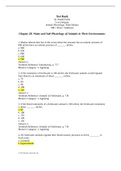
-
Animal Physiology, Third Edition Hill • Wyse • Anderson Chapter 28: Water and Salt Physiology of Animals in Their Environments
- Exam (elaborations) • 20 pages • 2022
- Available in package deal
-
- $9.49
- + learn more
1. Marine teleosts that live in the ocean where the seawater has an osmotic pressure of 800 mOsm have an osmotic pressure of _______ mOsm. a. 900 b. 850 c. 800 d. 600 e. 500 Answer: e Textbook Reference: Introduction, p. 717 Bloom’s Category: 3. Applying 2. If the osmolarity of freshwater is 100 mOsm, the freshwater animals would regulate their blood to an osmolarity of about _______ mOsm. a. 70 b. 80 c. 90 d. 100 e. 120 Answer: e Textbook Reference: Animals in Freshwater, p....

-
Animal Physiology, Third Edition Hill • Wyse • Anderson Chapter 29: Kidneys and Excretion
- Exam (elaborations) • 20 pages • 2022
- Available in package deal
-
- $9.49
- + learn more
1. Which of the following statements about the kidneys is false? a. They produce and eliminate aqueous solutions derived from the blood plasma. b. They include tubular structures that discharge product to the outside world. c. They produce and eliminate watery solutions derived from the extracellular fluid. d. They excrete solutes dissolved in water. e. They produce urine that contains high levels of creatinine, which is a direct product of lipid metabolism. Answer: e Textbook Reference:...
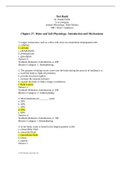
-
AnPhys3e Ch27 Test Bank|Animal Physiology,Third EditionHill • Wyse • Anderson| Chapter 27: Water and Salt Physiology: Introduction and Mechanisms
- Exam (elaborations) • 20 pages • 2022
- Available in package deal
-
- $9.49
- + learn more
Chapter 27: Water and Salt Physiology: Introduction and Mechanisms 1. Larger crustaceans, such as a blue crab, have an exoskeleton impregnated with a. cellulose. b. calcium. c. phospholipids. d. proteoglycans. e. glycolipids. Answer: b Textbook Reference: Introduction, p. 699 Bloom’s Category: 1. Remembering 2. The purpose of taking excess water into the body during the process of molting is to a. swell the body to fight off predators. b. provide structural rigidity. c. increase t...
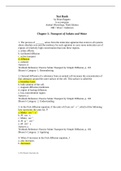
-
Third Edition Hill • Wyse • Anderson Chapter 5: Transport of Solutes and Water
- Exam (elaborations) • 29 pages • 2022
-
- $9.49
- + learn more
1. The process of _______ arises from the molecular agitation that exists in all systems above absolute zero and the tendency for such agitation to carry more molecules out of regions of relatively high concentration than into these regions. a. solute affinity b. facilitated diffusion c. active transport d. diffusion e. osmosis Answer: d Textbook Reference: Passive Solute Transport by Simple Diffusion, p. 101 Bloom’s Category: 1. Remembering 2. Outward diffusion of a substance from ...

-
Animal Physiology, Third Edition Hill • Wyse • Anderson Chapter 5: Transport of Solutes and Water
- Exam (elaborations) • 29 pages • 2022
-
- $9.49
- + learn more
Chapter 5: Transport of Solutes and Water 1. The process of _______ arises from the molecular agitation that exists in all systems above absolute zero and the tendency for such agitation to carry more molecules out of regions of relatively high concentration than into these regions. a. solute affinity b. facilitated diffusion c. active transport d. diffusion e. osmosis Answer: d Textbook Reference: Passive Solute Transport by Simple Diffusion, p. 101 Bloom’s Category: 1. Remembering...

Did you know that on average a seller on Stuvia earns $82 per month selling study resources? Hmm, hint, hint. Discover all about earning on Stuvia


